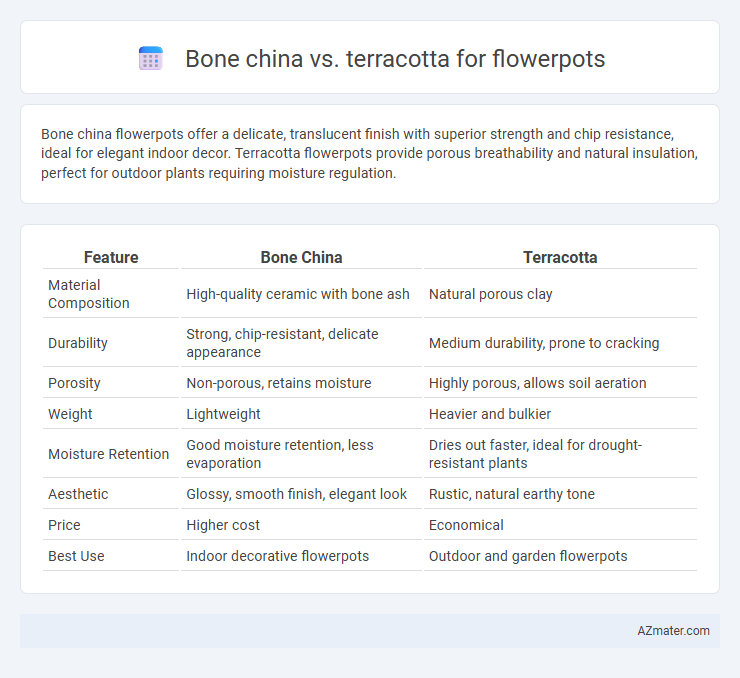Bone china flowerpots offer a delicate, translucent finish with superior strength and chip resistance, ideal for elegant indoor decor. Terracotta flowerpots provide porous breathability and natural insulation, perfect for outdoor plants requiring moisture regulation.
Table of Comparison
| Feature | Bone China | Terracotta |
|---|---|---|
| Material Composition | High-quality ceramic with bone ash | Natural porous clay |
| Durability | Strong, chip-resistant, delicate appearance | Medium durability, prone to cracking |
| Porosity | Non-porous, retains moisture | Highly porous, allows soil aeration |
| Weight | Lightweight | Heavier and bulkier |
| Moisture Retention | Good moisture retention, less evaporation | Dries out faster, ideal for drought-resistant plants |
| Aesthetic | Glossy, smooth finish, elegant look | Rustic, natural earthy tone |
| Price | Higher cost | Economical |
| Best Use | Indoor decorative flowerpots | Outdoor and garden flowerpots |
Introduction to Bone China and Terracotta Flowerpots
Bone china flowerpots are crafted from refined porcelain clay blended with bone ash, offering a smooth, durable, and translucent finish ideal for elegant indoor plant displays. Terracotta flowerpots are made from natural clay fired at lower temperatures, providing a porous, breathable texture that promotes healthy root aeration and moisture regulation for outdoor and rustic plant arrangements. Choosing between bone china and terracotta involves considering factors like aesthetic appeal, durability, and plant care requirements.
Material Composition: Bone China vs Terracotta
Bone china is a refined ceramic made from a mixture of bone ash, feldspathic material, and kaolin, offering a lightweight yet durable composition with a smooth, translucent finish. Terracotta, composed mainly of natural clay fired at lower temperatures, has a porous, matte surface that allows for better air and water permeability ideal for plant health. The dense, non-porous nature of bone china limits breathability but provides superior resistance to chipping, whereas terracotta pots promote root aeration and moisture evaporation beneficial for thriving flowers.
Aesthetic Appeal and Design Variations
Bone china flowerpots offer a sleek, glossy finish with delicate translucency that enhances fine floral arrangements, making them ideal for elegant indoor decor. Terracotta pots present a rustic, earthy texture with natural reddish-brown hues, providing a classic and organic aesthetic perfect for garden settings. Design variations in bone china include intricate patterns and smooth contours, while terracotta features handcrafted, rugged shapes that emphasize artisanal appeal.
Durability and Longevity Comparison
Bone china flowerpots offer superior durability due to their dense, vitrified composition, making them highly resistant to chipping and cracking compared to terracotta. Terracotta pots, while porous and excellent for breathability and moisture regulation, tend to be more fragile and susceptible to damage from frost and impact. Over time, bone china maintains its structural integrity and aesthetic appeal, resulting in greater longevity for outdoor and indoor gardening applications.
Water Retention and Drainage Capabilities
Bone china flowerpots offer low water retention due to their dense, non-porous surface, ensuring excellent drainage and minimizing root rot risks. Terracotta pots, being highly porous, retain moisture around plant roots while allowing excess water to evaporate, supporting healthy root aeration. Choosing between bone china and terracotta depends on the plant species' water needs, with terracotta better suited for plants requiring drier soil and bone china ideal for moisture-sensitive varieties.
Plant Health: Effects on Root Growth
Bone china flowerpots provide a non-porous, smooth surface that retains moisture evenly, promoting steady root hydration and preventing root desiccation. Terracotta pots are porous, allowing air circulation and moisture evaporation, which can encourage root aeration but may also lead to faster drying and potential root stress in hot climates. The ideal choice depends on plant species and watering routine, with bone china favoring moisture-sensitive roots and terracotta supporting plants requiring well-drained conditions.
Weather and Climate Suitability
Bone china flowerpots are less suitable for extreme weather conditions due to their delicate, porous nature and susceptibility to cracking in frost or intense heat. Terracotta flowerpots excel in moderate climates with good drainage properties and breathability, but they can absorb moisture and become fragile in freezing temperatures. For regions with fluctuating weather, terracotta offers better durability, while bone china is ideal for stable indoor environments or mild climates.
Maintenance and Cleaning Requirements
Bone china flowerpots require gentle cleaning with a soft cloth and mild detergent to prevent surface damage and maintain their delicate, glossy finish, avoiding abrasive materials that can cause scratches. Terracotta flowerpots demand regular, thorough cleaning to remove mineral buildup and algae, often requiring soaking and scrubbing with a brush to maintain porosity and prevent mold growth. While bone china is less porous and retains moisture better, terracotta's porous nature necessitates more frequent cleaning to avoid deterioration and prolong its lifespan.
Cost and Availability Analysis
Bone china flowerpots offer a premium aesthetic and smooth finish but come at a higher cost, often limiting availability to specialty retailers. Terracotta flowerpots are more affordable and widely available, making them a popular choice for budget-conscious gardeners. The porous nature of terracotta supports better airflow and moisture control, whereas bone china provides a non-porous, delicate option ideal for decorative indoor plants.
Environmental Impact and Sustainability
Bone china flowerpots offer limited environmental benefits due to their high energy consumption and raw material extraction involving bone ash and kaolin clay, which can contribute to resource depletion. Terracotta flowerpots are environmentally friendly as they are made from natural clay, require less energy to produce, and are biodegradable, supporting soil health when disposed of naturally. Their sustainable production and compostability make terracotta a preferable choice for eco-conscious gardeners seeking to minimize their ecological footprint.

Infographic: Bone china vs Terracotta for Flowerpot
 azmater.com
azmater.com